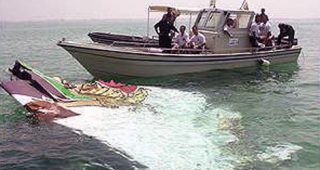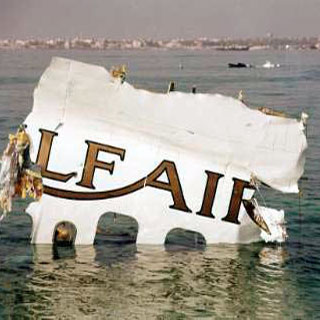GULF AIR flight GF072 crashed while on go-around in Bahrain international airport. On 23 August 2000, at about 1930 local time, Gulf Air flight GF-072, an Airbus A320-212, a Sultanate of Oman registered aircraft A40-EK, crashed at sea at about 3 miles north-east of Bahrain International Airport. GF-072 departed from Cairo International Airport, Egypt, with two pilots, six cabin crew and 135 passengers on board for Bahrain International Airport, Muharraq, Kingdom of Bahrain. GF-072 was operating a regularly scheduled international passenger service flight under the Convention on International Civil Aviation and the provisions of the Sultanate of Oman Civil Aviation Regulations Part 121 and was on an instrument flight rules (IFR) flight plan.
the captain did not possess sufficient spare information processing capacity to perceive and respond to the information from the aircraft’s instruments. Information from the instruments was filtered out.
GF-072 was cleared for a VOR/DME approach for Runway 12 at Bahrain. At about one nautical mile from the touch down and at an altitude of about 600 feet, the flight crew requested for a left hand orbit, which was approved by the air traffic control (ATC). Having flown the orbit beyond the extended centreline on a south-westerly heading, the captain decided to go-around. Observing the manoeuvre, the ATC offered the radar vectors, which the flight crew accepted.

GULF AIR flight GF072
GF-072 initiated a go-around, applied take-off/go-around thrust, and crossed the runway on a north-easterly heading with a shallow climb to about 1000 feet. As the aircraft rapidly accelerated, the master warning sounded for flap over-speed.
A perceptual study, carried out as part of the investigation, indicated that during the go-around the flight crew probably experienced a form of spatial disorientation, which could have caused the captain to falsely perceive that the aircraft was ‘pitching up’.
He responded by making a ‘nose-down’ input, and, as a result, the aircraft commenced to descend.
The ground proximity warning system (GPWS) voice alarm sounded: “whoop, whoop pull-up …”.
The GPWS warning of GULF AIR flight GF072 was repeated every second for nine seconds, until the aircraft impacted the shallow sea.
The aircraft was destroyed by impact forces, and all 143 persons on board were killed.
The factors contributing to the above accident were identified as a combination of individual and systemic issues.
The individual factors during the approach and final phases of the flight were:
- non-adherence to standard operating procedures (SOPs) by the captain;
- the first officer not drawing the attention of the captain to the deviations of the aircraft from the standard flight parameters and profile;
- the spatial disorientation and information overload experienced by the flight crew; and,
- the non-effective response by the flight crew to the ground proximity warnings.
The systemic factors that could have led to these individual factors were:
- a lack of a crew resources management (CRM) training programme;
- inadequacy in some of the airline’s A320 flight crew training programmes;
- problems in the airline’s flight data analysis system and flight safety department which were not functioning satisfactorily;
- organisational and management issues within the airline; and
- safety oversight factors by the regulator.
Any one of these systemic factors, by itself, was insufficient to cause a breakdown of the safety system. Such factors may often remain undetected within a system for a considerable period of time. When these latent conditions combine with local events and environmental circumstances, such as individual factors contributed by “front-line” operators or environmental factors, a system failure, such as an accident, may occur.
The investigation showed that no single factor was responsible for the accident to GF-072.
The accident was the result of a fatal combination of many contributory factors, both at the individual and systemic levels. All of these factors must be addressed to prevent such an accident happening again.
The airline has taken a number of post-accident safety initiatives to address some of these individual and systemic factors. The airline has reported that it is in the process of enhancing its flight crew training.
Download Report


0 Comments